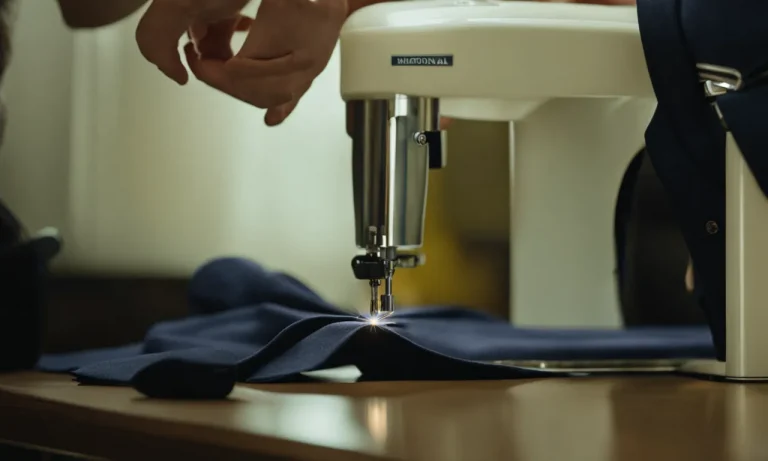How To Stretch Spandex Fabric: A Comprehensive Guide
Do your spandex leggings feel too tight? Have your swimsuits lost their stretch and shape? Don’t throw them out just yet! With the right techniques, you can easily stretch spandex fabric back to its original size and shape.
In this comprehensive guide, we’ll go over everything you need to know to effectively stretch spandex and make it feel like new again. If you’re short on time, here’s a quick answer: soak the spandex in very hot or boiling water, then gently pull and massage the fabric to coax it back into shape.
Read on for more details on how to safely stretch spandex without causing damage.
In this article, we’ll cover different methods for stretching spandex based on the fabric type and item. We’ll go over proper water temperatures, how to avoid damaging the material, tips for maximizing stretch, and more.
With the techniques outlined below, you can give old, saggy spandex a new lease on life.
Understand What Causes Spandex to Lose Elasticity
Spandex fabric is known for its exceptional stretch and recovery properties. However, over time, it can lose its elasticity due to various factors. Understanding the causes of spandex losing its elasticity can help you take the necessary steps to prevent or minimize this issue.
Chemicals, heat, and repeated stretching over time
Exposure to chemicals, such as chlorine from swimming pools or harsh detergents, can weaken the fibers of spandex, leading to a loss of elasticity. It is important to wash spandex garments using mild detergents and avoid using bleach or fabric softeners.
Heat is another factor that can affect the elasticity of spandex. High temperatures, whether from hot water in the washing machine or from a dryer, can cause the fibers to become damaged and lose their stretch.
It is recommended to wash spandex items in cold water and air dry them to preserve their elasticity.
Repeated stretching over time can also contribute to the loss of elasticity in spandex fabric. Each time spandex is stretched beyond its limits, the fibers can become overstretched and eventually lose their ability to bounce back.
It is important to handle spandex items with care and avoid excessive stretching or pulling.
How to inspect spandex items for loss of stretch
Regularly inspecting your spandex items for signs of loss of stretch can help you identify any issues early on. Here are a few things to look out for:
- Loose fit: If a spandex garment feels looser than it used to, it could be a sign that the fabric has lost its elasticity.
- Baggy appearance: Spandex garments that appear saggy or baggy, especially in areas that should be snug, may indicate a loss of stretch.
- Lack of recovery: When you stretch a spandex item and it fails to bounce back to its original shape, it may be a sign that the fabric has lost its elasticity.
If you notice any of these signs, it may be time to retire the spandex item or consider getting it repaired if possible.
For more information on how to care for spandex fabric and prevent the loss of elasticity, you can visit reputable websites such as Livestrong or The Spruce.
Prepare the Spandex Item Before Stretching
Before you start stretching your spandex fabric, it’s important to properly prepare the item. This will help ensure that you don’t damage the fabric and get the best results possible. Here are some steps to follow:
Check clothing tags for care instructions
Always begin by checking the clothing tags or care instructions that come with your spandex item. Different fabrics have different care requirements, and it’s essential to follow them to maintain the fabric’s integrity.
The tag may provide specific instructions on how to stretch the spandex fabric without causing any damage or distortion.
Wash item if heavily soiled
If your spandex item is heavily soiled, it’s a good idea to wash it before stretching. This will remove any dirt, sweat, or other impurities that may have accumulated on the fabric. Follow the washing instructions provided on the clothing tag or use a gentle cycle with cold water.
Avoid using harsh detergents or bleach as they can damage the fabric.
Avoid harsh detergents or fabric softeners
When washing your spandex item, it’s crucial to avoid using harsh detergents or fabric softeners. These products can break down the fibers of the fabric and cause it to lose its elasticity. Instead, opt for mild, gentle detergents specifically designed for delicate fabrics.
If you want to make your spandex item softer, consider using a fabric conditioner or vinegar rinse instead of fabric softeners.
For more detailed information on caring for spandex fabric, you can visit https://www.fabric.com/blog/how-to-care-for-spandex-fabric. They provide valuable tips and tricks to ensure your spandex items stay in great condition for a long time.
Use Hot or Boiling Water to Relax Fibers
When it comes to stretching spandex fabric, using hot or boiling water can be an effective method. Heat allows the fibers to move more freely, making it easier to stretch the fabric without causing any damage.
This technique is particularly useful for garments that have become too tight or have lost their original shape.
Temperature Guidelines Based on Fabric Composition
It’s important to consider the fabric composition before using hot or boiling water to stretch spandex. Different types of spandex blends may require different temperature guidelines. For example, a fabric that is made mostly of polyester and spandex can generally withstand higher temperatures compared to a fabric that is made mostly of cotton and spandex.
It’s always a good idea to check the care label or manufacturer’s instructions for specific temperature recommendations.
Immerse Item Fully and Allow to Soak
To stretch spandex fabric using hot or boiling water, start by filling a basin or sink with hot water. Make sure the water is hot enough to effectively relax the fibers but not so hot that it damages the fabric. Immerse the item fully in the water and allow it to soak for about 10 to 15 minutes.
This soaking time will help to soften the fabric and make it more pliable for stretching.
Don’t Leave in Water Too Long to Avoid Damage
While hot or boiling water can be effective for stretching spandex, it’s important not to leave the fabric in the water for too long. Prolonged exposure to hot water can damage the fabric and affect its elasticity.
After the recommended soaking time, remove the item from the water and gently stretch it to the desired shape and size. If additional stretching is needed, repeat the process, making sure to use fresh hot water each time.
Remember, stretching spandex fabric using hot or boiling water is just one method. It’s always a good idea to test a small, inconspicuous area of the fabric first to ensure that there is no adverse reaction.
If you’re unsure about stretching your spandex item, it’s best to consult with a professional or follow the manufacturer’s instructions.
Gently Stretch and Massage the Spandex
When it comes to stretching spandex fabric, a gentle approach is key. By following a few simple steps, you can ensure that your spandex retains its shape and elasticity. One important technique is to pull the fabric gently in all directions while it is wet.
This helps to evenly distribute the stretch and prevent any potential damage. Wetting the fabric before stretching can make the process easier and less likely to cause stress on the fibers.
Pull fabric gently in all directions while wet
When stretching spandex, it’s important to handle the fabric with care. Start by wetting the fabric thoroughly. This can be done by either spraying it with water or soaking it in a basin of lukewarm water for a few minutes. Once the fabric is wet, gently pull it in all directions to stretch it.
This will help to maintain the fabric’s shape and prevent it from becoming misshapen or distorted.
Avoid overly aggressive pulling or tugging
While it’s important to stretch spandex fabric, it’s equally important to avoid overly aggressive pulling or tugging. Spandex is a delicate material that can easily lose its elasticity if stretched too forcefully. Instead, opt for a gentle and gradual approach.
Apply even pressure while stretching the fabric and avoid any sudden jerking or pulling motions. This will help to preserve the fabric’s stretch and prevent any potential damage.
Massage and knead to maximize stretch
In addition to gently stretching the spandex fabric, massaging and kneading it can also help to maximize its stretch. Using your hands, massage the fabric in circular motions. This will help to relax the fibers and allow for increased elasticity.
Kneading the fabric between your fingers can also help to loosen any tight areas and improve the overall stretch of the fabric.
For severe loss of stretch, repeat soaking and stretching
If your spandex fabric has experienced a severe loss of stretch, don’t despair. There is still hope for restoring its elasticity. Simply repeat the process of soaking and stretching the fabric. This can help to gradually restore the fabric’s stretch over time.
Remember to be patient and avoid rushing the process. It may take multiple repetitions before you notice a significant improvement in the fabric’s stretch.
By following these tips and techniques, you can effectively stretch spandex fabric without causing any damage. Remember to be gentle, avoid aggressive pulling or tugging, and take your time to massage and knead the fabric.
With a little patience and care, you can restore the elasticity of your spandex fabric and ensure it retains its shape for years to come.
Let Item Air Dry While Stretched
After stretching your spandex fabric, it’s important to let it air dry in its stretched state. This will help to maintain its shape and prevent it from shrinking back to its original size. There are a few methods you can use to achieve this.
Lay flat or hang to dry in stretched state
One option is to lay the fabric flat on a clean surface or hang it up, making sure it is stretched out evenly. This will allow the fabric to dry naturally while maintaining its stretched shape. Make sure to choose a location where the fabric won’t be disturbed or accidentally pulled, as this could cause it to lose its stretch.
Use clamps on edges to keep stretched
If you’re concerned about the fabric losing its shape while drying, you can use clamps on the edges to help keep it stretched. Simply secure the edges of the fabric with clamps or clothespins to maintain the stretch. This method can be particularly useful for larger pieces of fabric or garments.
Do not put in dryer until fully dried
It’s important to avoid putting your spandex fabric in the dryer until it is fully dried. Putting it in the dryer prematurely can cause it to shrink or lose its stretch. Instead, allow the fabric to air dry completely before considering any additional drying methods.
Remember, proper care and maintenance of your spandex fabric will help ensure its longevity and keep it looking great. Following these guidelines for drying your spandex fabric will help maintain its stretch and shape, allowing you to enjoy it for years to come.
Conclusion
With some heat, water, and TLC, you can breathe new life into old, sagging spandex clothes and accessories. Just be sure to follow material care instructions and avoid extreme temperatures or pulling to prevent damage.
Stretching spandex properly keeps it elastic and saves your favorite activewear and swimwear from the trash bin. Our comprehensive guide outlines techniques to safely stretch spandex based on the fabric type and construction.
Just remember to be gentle, take your time, and work the material gradually. With our tips, you’ll give limp spandex a new lease on stretch in no time!







